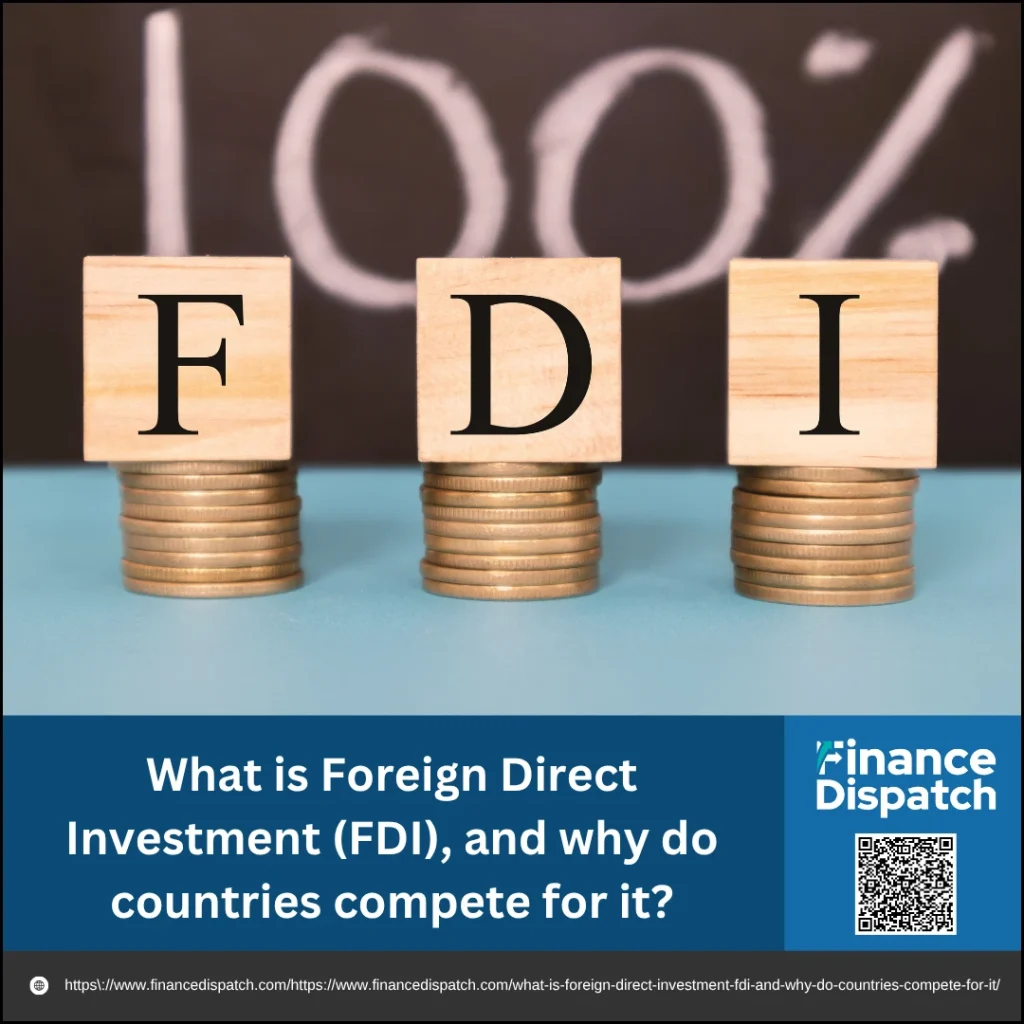In today’s interconnected world, Foreign Direct Investment (FDI) has become a cornerstone of global economic growth and cooperation. It involves a long-term investment by an individual, company, or government from one country into business interests in another, often resulting in direct control or substantial influence over the foreign enterprise. Unlike passive investments in stocks or bonds, FDI fosters deeper engagement through management, technology transfer, and job creation. For many countries—especially developing economies—FDI is not just a source of capital but a powerful catalyst for infrastructure development, industrial diversification, and global trade integration. This explains why nations actively compete to attract and retain foreign investors.
What is Foreign Direct Investment (FDI)?
Foreign Direct Investment (FDI) refers to the investment made by an individual, company, or government from one country into a business or enterprise located in another country, with the intention of establishing a lasting interest and exercising significant influence or control. This typically involves acquiring at least 10% of the voting power in a foreign company, a threshold that distinguishes FDI from foreign portfolio investments. Unlike passive investments, FDI reflects an active and long-term commitment, often including not just capital but also management expertise, technology, and operational involvement. It plays a crucial role in global economic integration by building enduring links between economies.
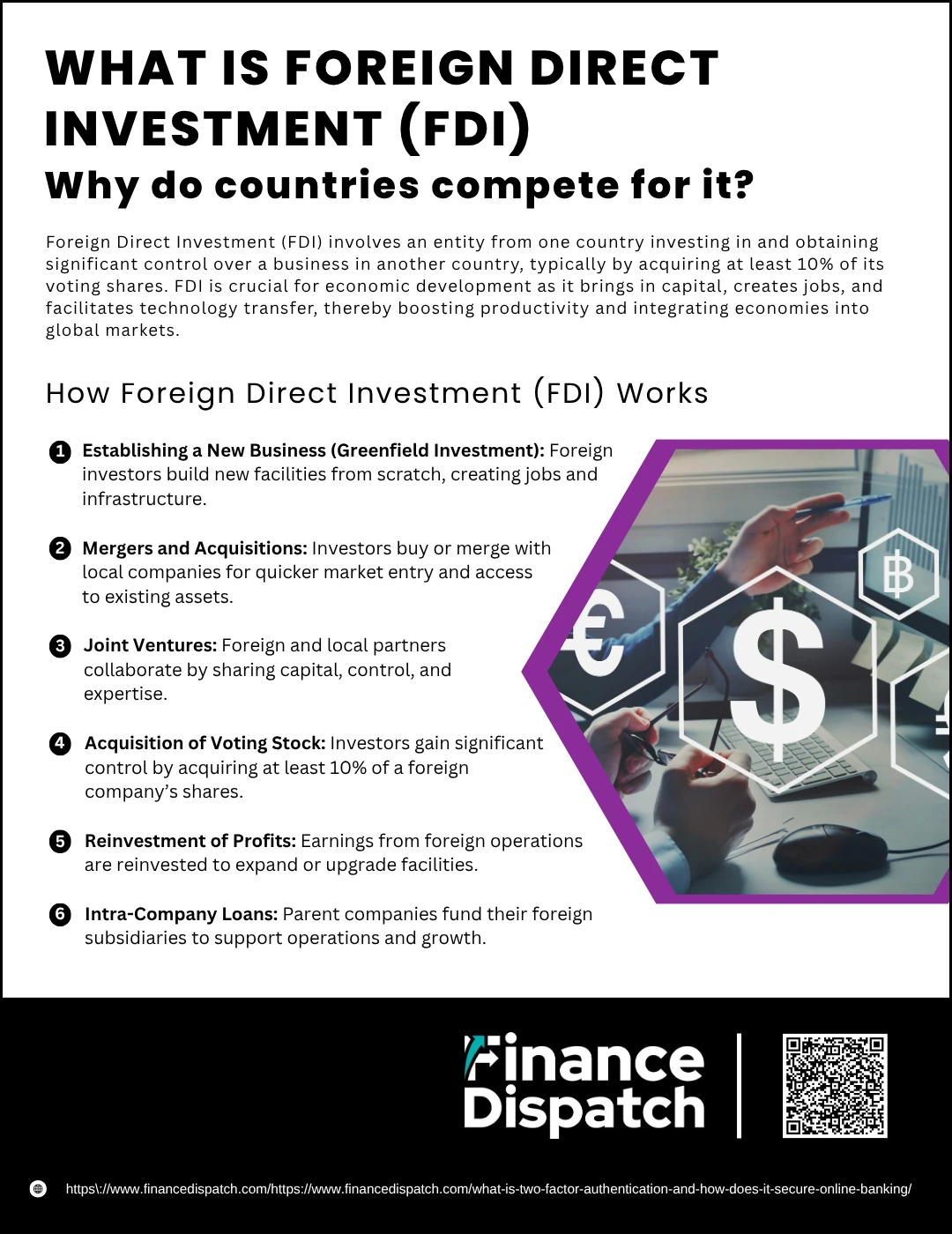 How FDI Works
How FDI Works
Foreign Direct Investment (FDI) is more than just the movement of capital—it’s a strategic move by investors to gain long-term control or influence over foreign business operations. Unlike passive investments like buying foreign stocks or bonds, FDI usually involves hands-on participation in the management and operations of the business. It facilitates the cross-border transfer of not just money, but also technology, skills, management practices, and infrastructure. This form of investment can significantly enhance the productivity and competitiveness of the host economy. Below are the main ways FDI is typically carried out:
1. Establishing a New Business (Greenfield Investment)
In a greenfield investment, a foreign investor builds a new business or facility from the ground up in the host country. This includes acquiring land, constructing buildings, installing equipment, and hiring employees. It often brings the most economic benefits to the host country, such as job creation and infrastructure development.
2. Mergers and Acquisitions
Investors may choose to buy or merge with an existing local company. This provides faster market access and leverages the existing brand reputation, distribution channels, or supply chains of the acquired firm. However, it may raise concerns about competition or ownership of key domestic industries.
3. Joint Ventures
A joint venture involves collaboration between a foreign investor and a local partner. Both parties contribute capital and share control over the venture. This method allows foreign investors to benefit from local knowledge while the domestic partner gains access to foreign capital and expertise.
4. Acquisition of Voting Stock
Acquiring a significant share (typically 10% or more) in a foreign company gives the investor influence over its decision-making processes. This method is often used when direct management involvement is not required but strategic alignment and oversight are desired.
5. Reinvestment of Profits
Profits earned from existing foreign operations can be reinvested into expanding production capacity, entering new market segments, or upgrading facilities. This signals long-term commitment and can deepen the economic relationship between the investor and host country.
6. Intra-Company Loans
These are loans provided by a parent company to its foreign subsidiary. They are used to support short-term financial needs, fund expansion, or stabilize operations during economic downturns. Though not direct equity investments, they are considered part of FDI when they reflect sustained economic interest.
Types of FDI
Foreign Direct Investment (FDI) takes several distinct forms based on the investor’s objectives and the nature of the business activity. Each type reflects different strategies for entering and operating within foreign markets. Whether a company aims to replicate its existing operations, control part of its supply chain, diversify into new sectors, or use the host country as a global export base, the approach it chooses determines the type of FDI. Understanding these categories is essential for evaluating their economic impact and alignment with national development goals.
| Type of FDI | Description | Example |
| Horizontal FDI | The investor establishes or acquires a similar business operation in a foreign country. | McDonald’s opening restaurants in Japan—same business model in a new market. |
| Vertical FDI | The investor expands into a different stage of the supply chain in another country. | A car company acquiring a foreign tire manufacturer (backward integration). |
| Conglomerate FDI | Investment in a completely unrelated business sector in a foreign country. | Virgin Group (UK) investing in a fashion company in France. |
| Platform FDI | A foreign investment made to serve export markets, not the host country’s domestic market. | Ford building a plant in Ireland to export cars across the EU. |
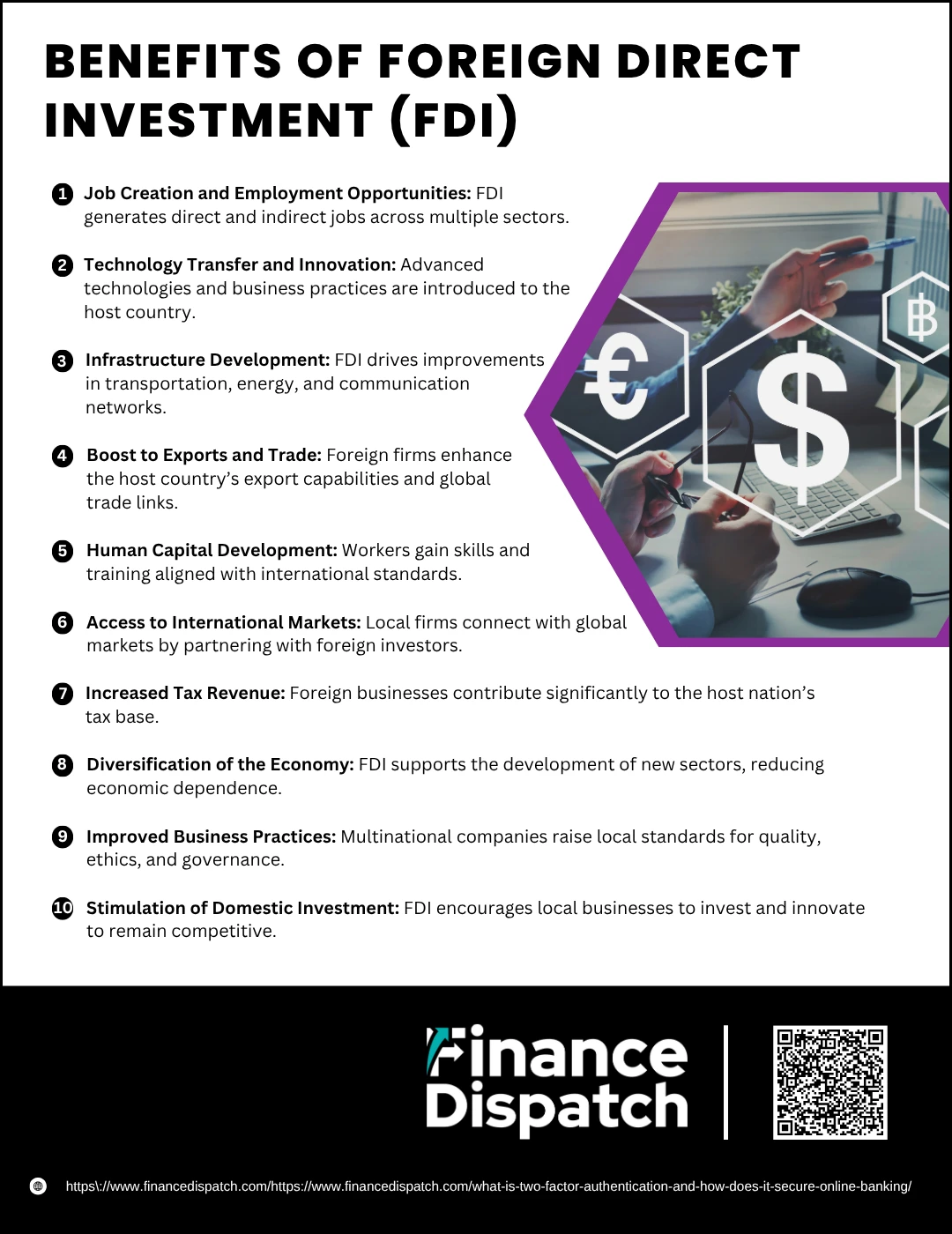 Benefits of FDI
Benefits of FDI
Foreign Direct Investment (FDI) plays a transformative role in the economic and social development of countries, especially emerging and developing economies. It goes beyond the simple transfer of capital—FDI fosters job creation, improves infrastructure, facilitates technology transfer, and connects domestic industries to global value chains. At the same time, it benefits investors by offering access to new markets, cheaper inputs, and a competitive business environment. When managed effectively, FDI can stimulate inclusive and sustainable economic growth while strengthening international economic relationships.
1. Job Creation and Employment Opportunities
FDI contributes to employment generation by establishing new companies or expanding existing ones in the host country. This includes direct jobs within the investing firms and indirect employment in supporting sectors like logistics, retail, and construction.
2. Technology Transfer and Innovation
Foreign investors bring with them cutting-edge technologies, research and development expertise, and innovative business models. This helps domestic firms adopt advanced methods, improve their competitiveness, and enhance productivity across sectors.
3. Infrastructure Development
FDI projects often require strong physical infrastructure. As a result, investments are frequently accompanied by improvements in roads, energy grids, ports, and telecommunications, benefiting the overall economy and local communities.
4. Boost to Exports and Trade
Many foreign investors set up production facilities aimed at international markets. This strengthens the host country’s export base and fosters its integration into global trade networks, ultimately improving the balance of payments.
5. Human Capital Development
FDI leads to skill enhancement through employee training, workshops, and professional development. Local workers gain exposure to international standards, which elevates the country’s human resource capabilities.
6. Access to International Markets
Partnering with or supplying goods to multinational companies can open doors for local firms to enter international markets, helping them grow beyond their domestic reach.
7. Increased Tax Revenue
Governments benefit from the taxes paid by foreign enterprises, including corporate income taxes, property taxes, and value-added taxes. These revenues can be reinvested in public services such as education, health, and infrastructure.
8. Diversification of the Economy
FDI allows countries to develop new sectors and industries, reducing reliance on traditional sectors like agriculture or mining. This economic diversification can make economies more resilient to global shocks.
9. Improved Business Practices
The presence of multinational firms often raises the bar for local businesses in terms of transparency, quality standards, environmental responsibility, and governance practices.
10. Stimulation of Domestic Investment
The entry of foreign investors often inspires local businesses to enhance their capabilities to stay competitive, leading to a rise in domestic investment and entrepreneurship.
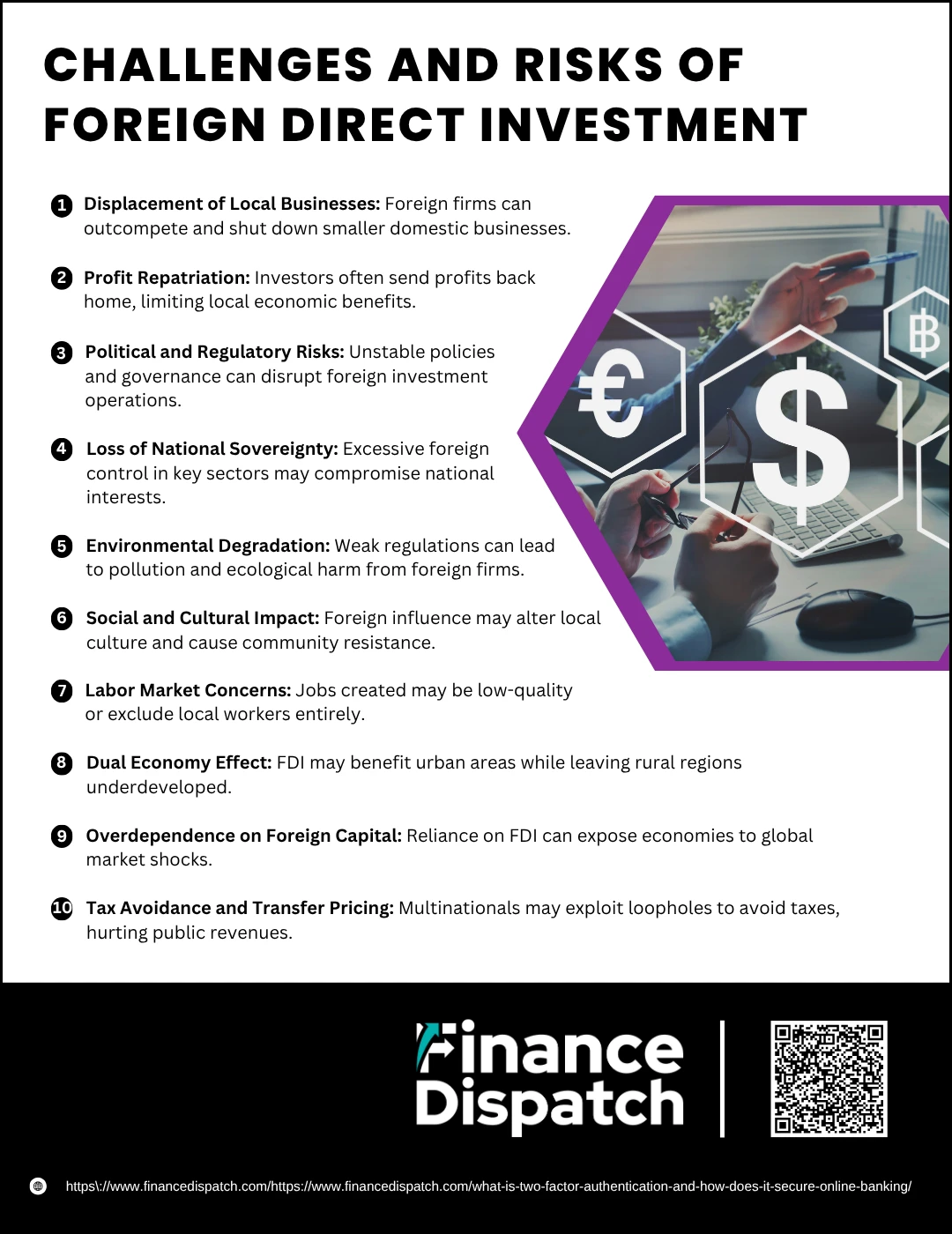 Challenges and Risks of FDI
Challenges and Risks of FDI
Foreign Direct Investment (FDI) has the potential to bring prosperity, modern technology, and jobs to a country—but it is not without its complications. While the inflow of foreign capital can stimulate growth, it may also pose serious challenges, especially for developing nations with less robust legal and regulatory systems. FDI can strain local economies, displace domestic industries, and create imbalances that are difficult to correct. Moreover, the motivations of foreign investors may not always align with the long-term interests of the host country. For FDI to be truly beneficial, these risks must be acknowledged and managed with sound policy and oversight.
1. Displacement of Local Businesses
When large multinational corporations enter a new market, they often bring superior technology, economies of scale, and aggressive pricing strategies. This can make it extremely difficult for small and medium-sized local businesses to compete, leading to closures, job losses, and a decline in entrepreneurial activity.
2. Profit Repatriation
Many foreign investors send a substantial portion of their profits back to their home countries rather than reinvesting locally. This limits the financial gains for the host economy and can create a continuous outflow of capital that weakens the domestic financial system over time.
3. Political and Regulatory Risks
FDI is highly vulnerable to changes in political leadership, unstable governance, or shifting regulatory frameworks. New laws, corruption, and policy reversals can disrupt operations, increase compliance costs, and even force foreign companies to exit the market unexpectedly.
4. Loss of National Sovereignty
Heavy foreign investment in critical industries such as natural resources, energy, or defense can give outside parties disproportionate influence over a country’s strategic assets. This may lead to conflicts of interest, especially if national priorities differ from investor goals.
5. Environmental Degradation
In their pursuit of profit, some foreign firms may exploit lax environmental regulations, leading to pollution, deforestation, and long-term ecological damage. Without strong enforcement, host countries may suffer severe environmental and public health consequences.
6. Social and Cultural Impact
The arrival of foreign companies may bring changes in workplace culture, consumer behavior, and even social values. This can lead to cultural erosion or resistance from local communities who feel alienated or marginalized by foreign practices and management styles.
7. Labor Market Concerns
Although FDI often creates jobs, those jobs may be low-paying, temporary, or outsourced. In some cases, foreign firms import skilled labor from their home country, bypassing local workers and limiting skill development and upward mobility for the domestic workforce.
8. Dual Economy Effect
FDI may disproportionately benefit urban, industrialized sectors while neglecting rural or traditional areas. This creates a two-tier economy where foreign-funded industries thrive while local sectors stagnate, widening the economic gap within the country.
9. Overdependence on Foreign Capital
When a country becomes overly reliant on foreign investment, its economy may become vulnerable to sudden shifts in investor confidence. Any political instability, currency devaluation, or global recession could trigger an abrupt withdrawal of FDI, destabilizing the economy.
10. Tax Avoidance and Transfer Pricing
Many multinational corporations use transfer pricing—setting prices for transactions between their own subsidiaries in different countries—to shift profits to low-tax jurisdictions. This practice deprives host countries of valuable tax revenue and creates an uneven playing field for local businesses that pay their full share.
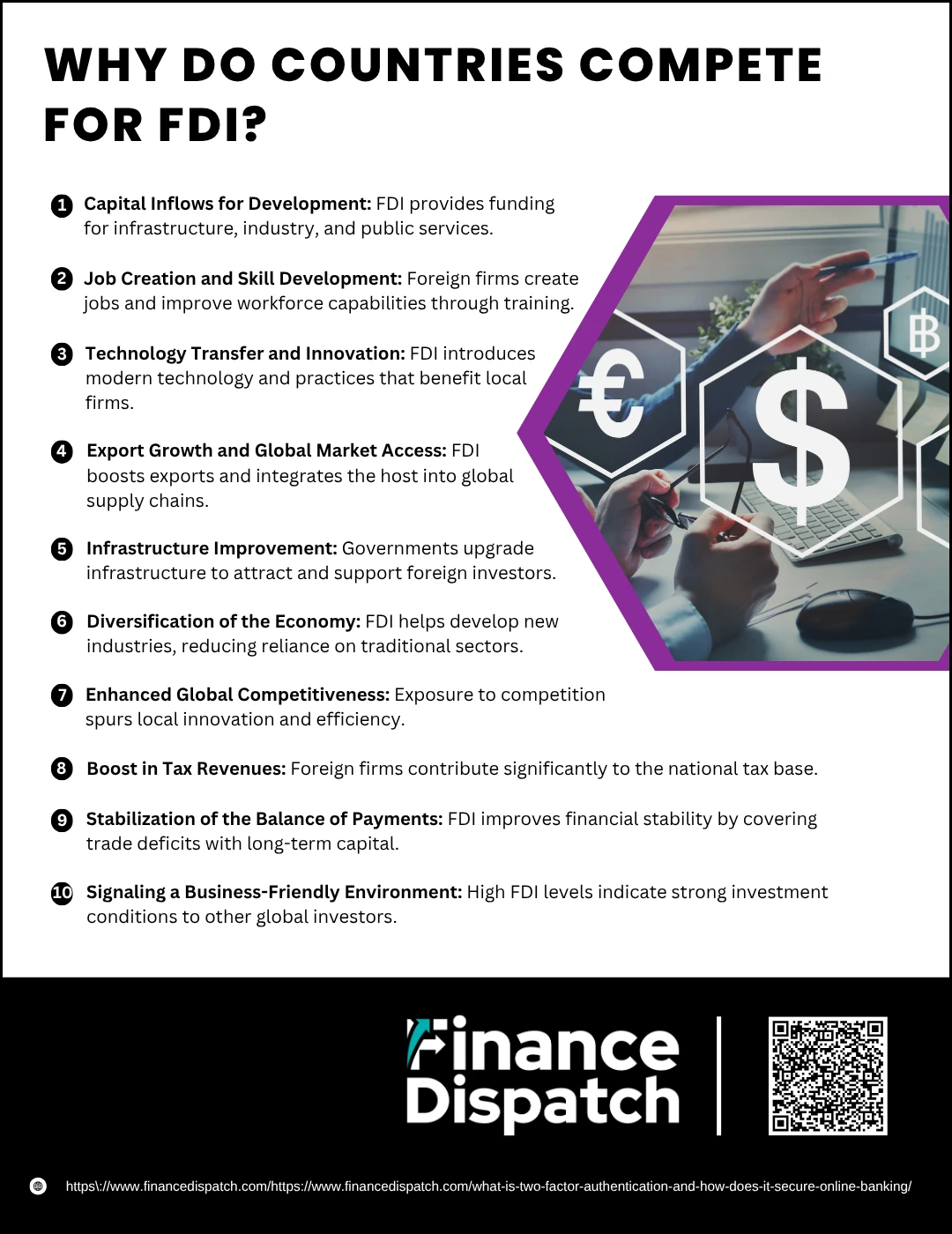 Why Do Countries Compete for FDI?
Why Do Countries Compete for FDI?
In the modern global economy, Foreign Direct Investment (FDI) is more than just a flow of capital—it is a strategic tool that shapes economic trajectories and strengthens a country’s integration into international markets. Governments around the world recognize that attracting FDI can fuel long-term development, reduce unemployment, stimulate innovation, and elevate the overall standard of living. As a result, countries actively compete for FDI by implementing favorable policies, offering incentives, and marketing themselves as stable, business-friendly environments. This competition is particularly fierce among developing nations that seek to close the gap with industrialized economies and attract the attention of multinational corporations.
1. Capital Inflows for Development
FDI brings in substantial financial resources that can fund infrastructure projects, build industries, and support public services. For countries with limited domestic capital or access to financial markets, FDI serves as a critical engine of growth.
2. Job Creation and Skill Development
When foreign companies establish operations, they hire local workers and often provide training and skill development. This contributes to employment, improves productivity, and enhances the quality of the workforce in the host country.
3. Technology Transfer and Innovation
Multinational firms introduce advanced technologies, management practices, and production techniques. These innovations often spread to local firms and institutions, leading to overall modernization and industrial upgrading.
4. Export Growth and Global Market Access
Many FDI projects target export markets rather than just domestic sales. This increases a country’s export capacity and helps integrate it into global supply chains, boosting trade performance and foreign exchange earnings.
5. Infrastructure Improvement
To accommodate the needs of foreign investors, governments often invest in transportation, utilities, and communication systems. This not only benefits the investors but also strengthens the country’s economic foundation and benefits local communities.
6. Diversification of the Economy
FDI can stimulate development in non-traditional sectors such as information technology, pharmaceuticals, and renewable energy. This diversification reduces economic vulnerability and creates more balanced, resilient growth.
7. Enhanced Global Competitiveness
Exposure to international competition pushes local businesses to improve quality, reduce costs, and innovate. Over time, this enhances a country’s global competitiveness and builds stronger domestic industries.
8. Boost in Tax Revenues
Profitable foreign enterprises contribute to national budgets through corporate taxes, employment taxes, and value-added taxes. These revenues can then be reinvested in education, healthcare, and public infrastructure.
9. Stabilization of the Balance of Payments
FDI is generally more stable than short-term capital flows. It helps cover trade deficits and reduces dependence on external borrowing, contributing to financial stability and creditworthiness.
10. Signaling a Business-Friendly Environment
High levels of FDI signal to other global investors that a country offers a stable political environment, transparent regulations, and a healthy investment climate. This can trigger a virtuous cycle of continued foreign and domestic investment.
How Countries Attract FDI
Attracting Foreign Direct Investment (FDI) has become a key objective for governments seeking to accelerate economic development, create jobs, and enhance competitiveness. To stand out in a competitive global landscape, countries implement targeted strategies to make themselves more appealing to international investors. These measures often involve a mix of economic incentives, regulatory reforms, infrastructure upgrades, and policy stability. The goal is to reduce investment risks and provide an environment where foreign businesses can operate efficiently and profitably.
1. Tax Incentives: Offering reduced corporate tax rates, tax holidays, or exemptions to lower the cost of doing business for foreign investors.
2. Special Economic Zones (SEZs): Creating designated areas with favorable regulatory conditions, simplified procedures, and dedicated infrastructure to support investment.
3. Investment-Friendly Policies: Simplifying bureaucratic procedures, ensuring transparency, and reducing red tape to make it easier to start and run a business.
4. Political and Economic Stability: Maintaining a stable government, sound fiscal policies, and clear legal frameworks to foster investor confidence.
5. Skilled Labor Force: Investing in education, training, and workforce development to ensure availability of skilled human capital that meets business needs.
6. Strong Infrastructure: Developing modern transportation, energy, telecommunications, and logistics systems to support efficient business operations.
7. Trade Agreements and Market Access: Participating in regional or international trade agreements that give foreign investors access to larger markets with reduced tariffs.
8. Protection of Investor Rights: Establishing laws that protect property rights, enforce contracts, and allow fair dispute resolution to reduce legal risks.
9. Public-Private Partnerships (PPPs): Engaging with foreign firms through collaborative investment in infrastructure or public services projects.
10. Proactive Promotion and Marketing: Actively promoting investment opportunities through trade missions, investment promotion agencies, and international forums.
Examples of Notable FDI Projects
Foreign Direct Investment (FDI) has led to transformative projects across various sectors, boosting local economies and expanding the global reach of major corporations. Here are some concise examples that highlight the scale and impact of notable FDI initiatives:
1. Walmart–Flipkart (India): Walmart’s $16 billion investment gave it a strong presence in India’s booming e-commerce market.
2. Tesla Gigafactory (Germany): A major greenfield project to produce electric vehicles for the European market.
3. Saudi Aramco–Reliance (India): A proposed $15 billion investment to expand oil and chemical operations.
4. Google–Jio Platforms (India): Google invested $4+ billion to support digital growth and innovation in India.
5. McDonald’s–China Expansion: A joint venture to rapidly scale McDonald’s outlets across China.
6. Belt and Road Initiative (Global): China’s multi-country infrastructure project to connect Asia, Africa, and Europe.
7. Amazon–Vancouver HQ (Canada): A tech hub expansion that created thousands of skilled jobs in Canada.
Conclusion
Foreign Direct Investment (FDI) is a powerful force in the global economy, enabling countries to access capital, technology, expertise, and international markets. It fosters economic development, drives industrial growth, and strengthens global trade relationships. However, FDI is not without its challenges—nations must carefully balance the benefits with potential risks such as overdependence, environmental concerns, and the displacement of local businesses. As countries continue to compete for FDI, success depends on creating a stable, transparent, and investor-friendly environment that aligns foreign investment with long-term national development goals. When managed wisely, FDI can be a transformative tool for inclusive and sustainable growth.



